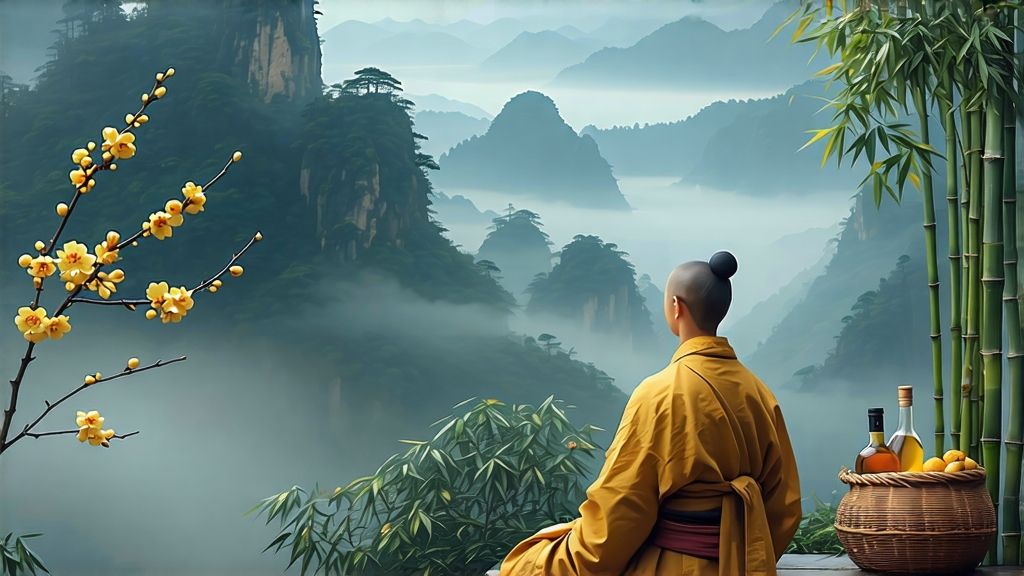
Among the six major chromatic families of Chinese tea, yellow tea is the rarest, its production secrets once confined to the walled gardens of emperors. Of the three celebrated yellow buds—Jun Shan Yin Zhen, Huo Shan Huang Ya, and Meng Ding Huang Ya—it is the last that best preserves the poetry of Tang-dynasty court tea while still thriving in the cool cloud forests of western Sichuan. This essay invites the international reader to journey into the folds of Mt. Meng, where a single downy bud is coaxed through one of tea’s most perilous transformations to yield a cup that tastes like warm apricot, mountain orchid, and the faint sweetness of rice broth.
Historical tapestry
Meng Ding (“蒙顶”) translates literally as “Summit of Mist”, a 1,456-metre ridge that rises above the Chengdu plain. Buddhist monks began planting tea here during the Han dynasty, and by the Tang (618-907 CE) the mountain’s first-flush buds were compressed into cakes and freighted along the Silk Road as far as Tibet and Samarkand. When Song emperor Huizong decreed in 1107 that “all tribute tea must be yellow,” local artisans invented the slow “sealed yellowing” step that oxidises leaf pigments just enough to turn the liquor the colour of imperial robes. For eight centuries Meng Ding Huang Ya remained a tax paid in leaves; only after the 1980s agricultural reforms did small family workshops reclaim the craft, yet annual output still hovers below fifteen tonnes—rarer than many grand cru Burgundies.
Micro-terroir
The mountain’s unique “three clouds a day” phenomenon—morning mist, noon cloudburst, evening fog—filters sunlight into a soft, shifting chiaroscuro. Camellia sinensis var. sinensis bushes, many of them 60-year-old seed-propagated shrubs, root directly into a sandstone-loam mix rich in selenium and rare earths. Night temperatures can plunge 12 °C below daytime highs, forcing the plant to store amino acids; the result is a bud whose L-theanine content rivals gyokuro, yet whose cell walls remain thin enough for yellowing enzymes to penetrate.
Plucking calendar
Authentic Meng Ding Huang Ya is picked only between the Qingming festival (4–6 April) and Grain Rain (19–21 April), when the bud has reached exactly 2.0–2.5 cm but the first leaf remains furled like a paper scroll. Experienced plachers (always women, always gloved) snap the stem with the nail of the middle finger to avoid the copper smell of skin oils. A kilo of finished tea demands 42,000 such buds—roughly one morning’s work for six plachers.
Craft: the seven breaths
Village elders speak of “seven breaths” that guide the leaf from mountain to jar:
- Withering: buds are laid 3 cm thick on bamboo trays set in shaded corridors where mountain wind lowers moisture from 78 % to 68 % within three hours.
- Fixation: the leaves are hand-tossed in iron woks pre-heated to 140 °C for exactly 240 seconds; the goal is to kill grassiness while preserving the yellowing enzyme polyphenol oxidase.
- First rolling: while still warm, the buds are rolled on ratten mats into tight spirals; cell rupture is kept below 18 % to avoid premature oxidation.
- Sealed yellowing: the critical, almost mystical step. Rolls are wrapped in steamed yellow cotton cloth, then buried in a 25 cm-deep wooden chest lined with rice hulls. Chest temperature is maintained at 28 °C and 85 % humidity for 48–72 h; every 12 h the master opens the bundle to “listen” to the leaf—an aroma shift from orchid to apricot signals readiness.
- Second rolling: a lighter 5-minute roll to re-shape buds loosened by humidity.
- Bamboo firing: the tea is spread on a hóngbei basket suspended over a charcoal pit fired by local oak. The temperature curve follows a sine wave: 60 °C for 20 min, 45 °C for 40 min, 70 °C for 10 min—driving residual moisture to 4 % while gifting a whisper of smoked honey.
- Rest and sort: finished tea is left for ten days in unglazed clay jars so that the last trace of “fire qi” dissipates; yellow tips are then hand-sorted